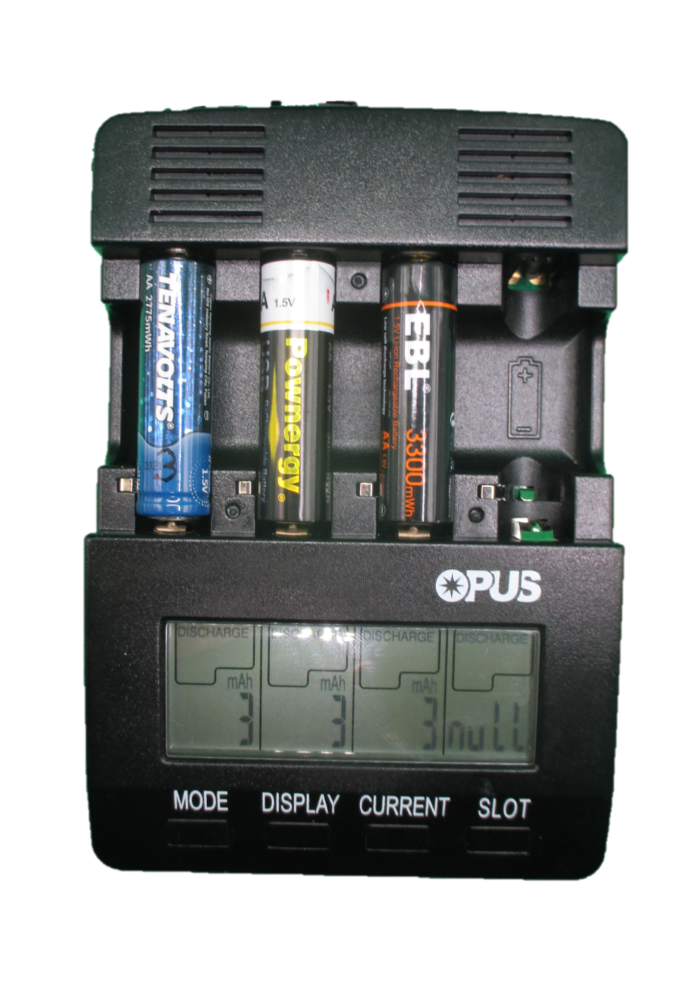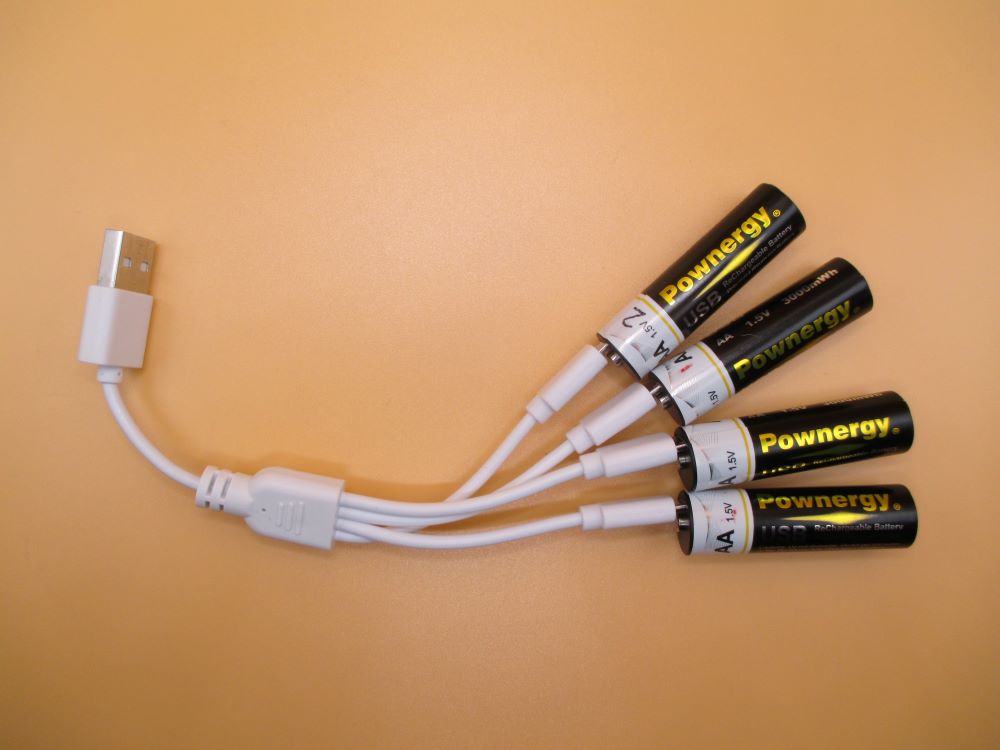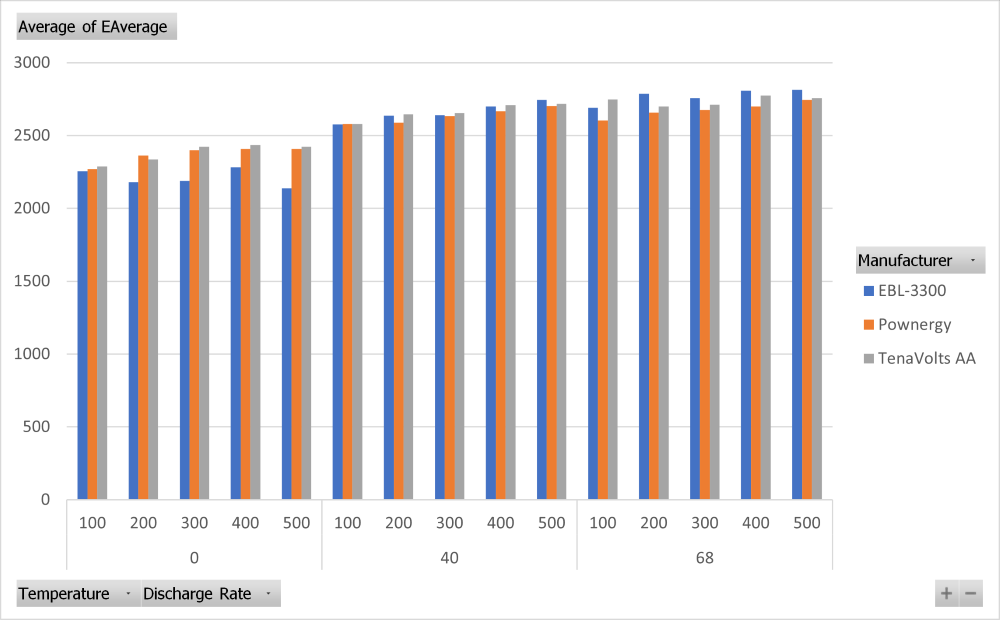Deep Tech: Rechargeable Li-Ion AA Batteries for Trail Cameras

In this post I look at the capacities of three brands of Li-Ion rechargeable AA batteries under trail camera conditions. In earlier posts I looked at general AA internal battery options for Trail Cameras. See: Trail Camera Batteries: Internal AA-Cell Options and Deep Tech: Trail Camera Batteries. In this post, I look specifically at rechargeable AA Li-Ion batteries from TenaVolts, EBL, and Pownergy. In addition to exploring capacity vs. temperature and discharge rates, I also discuss charging differences and limitations of these cells.
I am grateful to FaceBook-friend Derell Licht for suggesting this investigation, and for letting me borrow his new batteries for testing.
Battery Types Tested
In an earliet post, I covered Li-Ion AA cells from TenaVolts. In this post, I add two more to my list, the EBL-3300 and a battery from Pownergy. The table below gives the vendor-rated capacity and charging method for these batteries.
| Battery | Rated Capacity (mWh) | Charging Method |
| TenaVolts | 2775 | Custom Charger |
| Pownergy | 3000 | Micro-USB charging pigtail |
| EBL-3300 | 3300 | Micro-USB charging pigtail |
Note that EBL also has a lower capacity rechargeable Li-Ion AA batteries: 3000 mWh with similar charging mechanism to TenaVolts. I have not tested these.
The EBL Amazon site also lists a much lower cost, higher capacity, primary (non-rechargeable) “3000 mAh” (4500 mWh) AA “Li Metal” battery. This battery appears to be similar to Energizer Ultimate Lithium batteries. Don’t be confused (as I was, initially).
Charging Li-Ion AA Batteries
Each of these batteries requires a special charger designed to adapt to their power converter. Putting them in a AA recharger for NiMH AA cells will not work.
The TenaVolts batteries use a special charging block — as small as two batteries, and as large as 20. The 4-battery charger has a micro-USB socket.
The Pownergy and EBL batteries have micro-USB sockets built into the top of each battery, near the positive terminal. These batteries come with a USB-A to micro-USB pigtail which allows simultaneous charging of 4 batteries from a standard USB port.

I thought the micro-USB connectors might be awkward to use or fragile. However, I found that the pigtail charging cable worked surprisingly well in practice. It will be important to keep debris out of the micro-USB sockets on these batteries.
Charge Indication
In my opinion, the Pownergy and EBL batteries have a better charge indication system than TenaVolts cells. In the TenaVolts system, a blue LED lights up a ring around the base of the battery when it is charging. When charging is complete, the LED goes off. The problem with this scheme is that failure of the battery to charge also causes the blue LED to go off. This confuses the “not charged” with the “fully charged” state. You can avoid this ambiguity by making sure that the blue charging band comes on for all batteries when they are initially placed in the charger.
The Pownergy and EBL batteries use a two-color LED system. One color LED comes on when the batteries are actively charging, and another color LED when charging is complete. If you connect one of these the batteries to the micro-USB charger and no LEDs come on, something is wrong with the charger or the battery.
Li-Ion AA Battery Capacity vs. Load and Temperature
Below is graph summarizing capacities I measured of fully charged cells. I measured the full matrix of 5 load conditions (100 mA, 200 mA, 300 mA, 400 mA, and 500 mA) and and 3 temperatures (68F, 40F, 0F). Capacities are all in mWh — a unit of energy, not to be confused with mAh. For a discussion of battery capacity metrics, see my post Deep Tech: Trail Camera Batteries.

The advertised capacities of these batteries differ substantially, ranging from 2775 mWh (TenaVolts) to 3300 mWh (EBL-3300). Despite this large spread, I found the actual capacities to be essentially identical, and within the margin or error of my tests. The average over all loads and all temperatures for these three battery types are almost identical at ~2560 mWh. Ironically, the TenaVolts slightly leads the pack at 2590 mWh, followed by the Pownergy at 2560 mWh, and finally the EBL batteries at 2550 mWh. The EBL batteries have slightly higher capacity at room temperature, but perform less well at the very low temperatures likely to be encountered in some trail camera sets.
Per my earlier post Trail Camera Batteries: Internal AA-Cell Options, this is about half the capacity of new Lithium Iron Disulfide (Energizer Ultimate Lithium) primary cells over similar conditions. It is marginally better than the per-charge capacity of NiMH cells.
Li-Ion AA Battery Current Limitations
I found that all of these batteries performed well with discharge currents up to 500 mA (limitation of my battery tester), and temperatures down to 0F (-18 C). This range is well-matched to uses of most commercial trail cameras, even at night with LEDs active. However, I personally “burned out” 3 of 8 of the otherwise solid TenaVolts cells by using them in SB28 Xenon Flash units. Several of the Li-Ion battery vendors have since warned specifically against using these cells in high power devices, such as Xenon flash units. I was surprised to find that the SB28s draw a peak current of 7 Amps — much higher than than the ~1-2 Amp supported by power converters in these batteries.
In short, using these batteries in trail cameras with LED flashes should be fine. DSLR camera trappers — don’t use them in SB28s.
Summary
The 3 Li-Ion Battery types I measured for this post have practically identical capacities (~2560 mWh) when averaged over a range of discharge rates and operating temperature consistent with trail camera use. None of these batteries should be used in devices (like the Nikon SB28 flash) requiring peak or average currents greater than 1.0 – 2.0 Amps.
I generally prefer the two-color charge indicator system in the EBL and Pownergy batteries. This scheme gives positive indication that the battery is charging, is fully charged, or is not working correctly. But this is a slight preference. TenaVolts earns, praise from this author for their accurate marketing of the cell capacity.
This post does not address the longevity of these cells — advertised to be greater than 1000 charge-discharge cycles. All batteries I tested performed reliably and consistently over the 15 charge cycles for each battery I required for my testing.
Methods
I used a OPUS BT-C2400 battery tester to simultaneously discharge 4 batteries at rates of {100, 200, 300, 400, and 500} mA. I tested at 3-different temperatures by performing the discharges at room temperature, at 40 F inside our refrigerator, and at 0 F inside our freezer. To determine total energy in mWh, I multiplied the battery voltage shown on the tester 1 minute after the start of discharge, by the total mAh recorded for each cell by the tester. I started with new sets of 4 of each of the three battery types purchased from Amazon. Batteries were recharged completely between each test. The results reported reflect the average of 4 cells. The resulting measurements are likely accurate to within +/- 2%, with the primary source of error being slight variation in output voltage, and the fact that my battery tester records mAh, not mWh.
Raw Data
You can find a spreadsheet containing the raw measurements for each battery and each test condition on my github site.
References
- Tenavolts.com
- EBL-3300 mWh Batteries on Amazon
- Pownergy 3000 mWh Batteries on Amazon
- Ken Rockwell, Nikon SB-28 Speedlight SB28 Flash Test Review
- Which “Lithium” AA Rechargeable Battery is Best? Let’s find out! : Another AA Li-Ion Battery test that includes cells from other vendors. The author finds more voltage variation than I did. I’m not sure why this is. He also found substantially higher capacities for Blackup, AmpTorrent, and Vapcell brands — brands I did not measure. He does not measure temperature effects, nor batteries at different loads. I also can’t tell whether he made more than one measurement per cell. The most valuable section of this video (IMO) is graph a 9:19. The fan test between different brands of Li-Ion and NIMH cells is not, IMO, a good analog for trail camera use.

Thank you for your time in conducting this test. The information you gathered is very helpful to us camera trappers. Just when we thought there was light at the end of the tunnel(not a SB28’s light), we find the batteries shouldn’t be used in our flash of choice.
Glad you found this information useful. Regarding the SB28 — I was surprised by the peak current drawn by these devices, but not surprised by the limited power of the Li-Ion AA battery power converters. Providing more power would mean larger (and more expensive) components and packaging. 1-2 Amps likely covers >90% of devices. Indeed, the typical current required by even the SB28 is within this range. I think the high peak current drawn by the SB28’s is an incidental simplification of the power converter in the SB28s that generates the high voltage required to charge a the giant capacitor that powers the Xenon tube. The SB28 designers could have limited this peak current, but didn’t have to because it worked fine with the batteries of the day. There is some evidence that the newer AA Li-Ion batteries (e.g. Pownergy and EBL3300) have a more sophisticated microcontroller to limit power. Which is to say, they may “work” in an SB28 without becoming permanently damaged. But I haven’t done that experiment.
Thanks for commenting!
I was using regular lithium batteries – not re-chargeable – and had a big problem. One of the 8 batteries would discharge before the others and shut the camera down. The location of the one battery varied. As soon as I switched to ni-mh re-chargeable batteries, the problem was solved.
Glad to hear that NiMH batteries are working for you. Thanks for commenting.
Thank you for the great and in depth review. Very much appreciated.
Glad you found it valuable. Thanks for commenting!
Hi Bob,
So are you saying that these rechargeable LITHIUM ION batteries have advanced in technology that they are now OK to use in our trail cameras!? FINALLY!!
Your article is well written but I don’t really get have any background to understand the importance of the data, so these questions may be have been answered, but I could use a layman’s translation. Thank you for this research – and your patience with nontechnical camera trappers.
What is the most important parameters I should be looking for in these types of batteries when buying them? (Besides looking for your top recommendation) Capacities?
These new type of batteries, rechargeable lithium, can hold their charge down past freezing (32F) down to 0 degrees? That kind of cold, say for at least 30 days won’t make them any less effective? Besides minimal loss any battery would experience over time, even if it wasn’t below freezing temps?
Their ability to be recharged so many times makes them actually cheaper than buying the top rated Energizer Lithium batteries in the long run? Hoping you say yes here.
Will the internal trail camera battery meter be able to accurately measure battery life as the battery is used? If not, if I were to test the battery with an multimeter, what number would I be looking for to know when to change out the batteries in the camera?
What would someone without a multimeter do?
How will I know that the batteries are finally past useful life – for a trail camera, and to stop using them?
Your articles are so relevant to what we camera trappers want to know – thank you for your time and abilities to do all this testing. And then give it away free to all of us!
Thank you Bob!
Good questions, all, as usual! (thanks for repeat commenting)
1. Most important factor when considering these batteries is quality — i.e. the longevity of the battery in actual use. In the models I looked at, factors like capacity and temperature behavior were very similar across vendors. Unfortunately, I don’t enough data to assess this critical metric. For now, best to look at reviews, search trail camera forums, etc. to try to get a sense of this.
2. Low temperatures generally reduce charge capacities during use. Simply storing these at low temperatures does not decrease capacity. I notice that the EBL 3300 battery has two specs for storage at high temperatures: “Storage Temperature: -20℃~+60℃ Less than 1 month, -20℃~+30℃ Less than 6 months”
3. Long term costs: Simple answer is that if you expect to use them long enough to cover the lives of ~8 sets of EULS (16 full charges), then they’re less expensive. Long answer in https://winterberrywildlife.ouroneacrefarm.com/2021/11/10/trail-camera-batteries-internal-aa-cell-options/ . Excruciatingly long answer (with spreadsheet model an everything) at: https://winterberrywildlife.ouroneacrefarm.com/deep-tech-trail-camera-batteries/
4. State of Charge: The power converter in these batteries almost perfecty hides the state of charge. Not even your volt meter will help you because the power converter will output the same voltage on the battery terminals even as the (inaccessible) voltage on the internal battery drops, and even at different loads The vendor could make this information available via the USB charging port, but I don’t think they do. You can keep track of the number of photos and videos taken since last charge, and swap when they exceed a threshold (e.g. ~4 hours of video). But easiest thing to do is to swap in a freshly charged set of batteries every time you service the camera. With an expected lifetime of >1000 charge cycles, even if you did this every week, the batteries would last ~20 years.
5. End of Expected Life: Mark a day on your calendar for 2032 🙂 Seriously, these batteries should last for many years with little loss of capacity. If you are very concerned, you could buy a battery discharge tester (like the OPUS model I reference in this post), and check their capacity every 10-20 charges. But this will likely give you very uninteresting (if reasssuing) results for a long time.